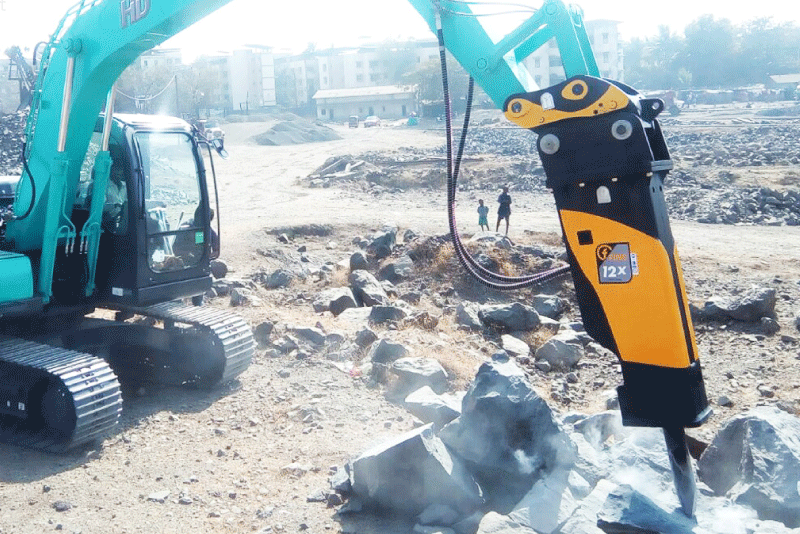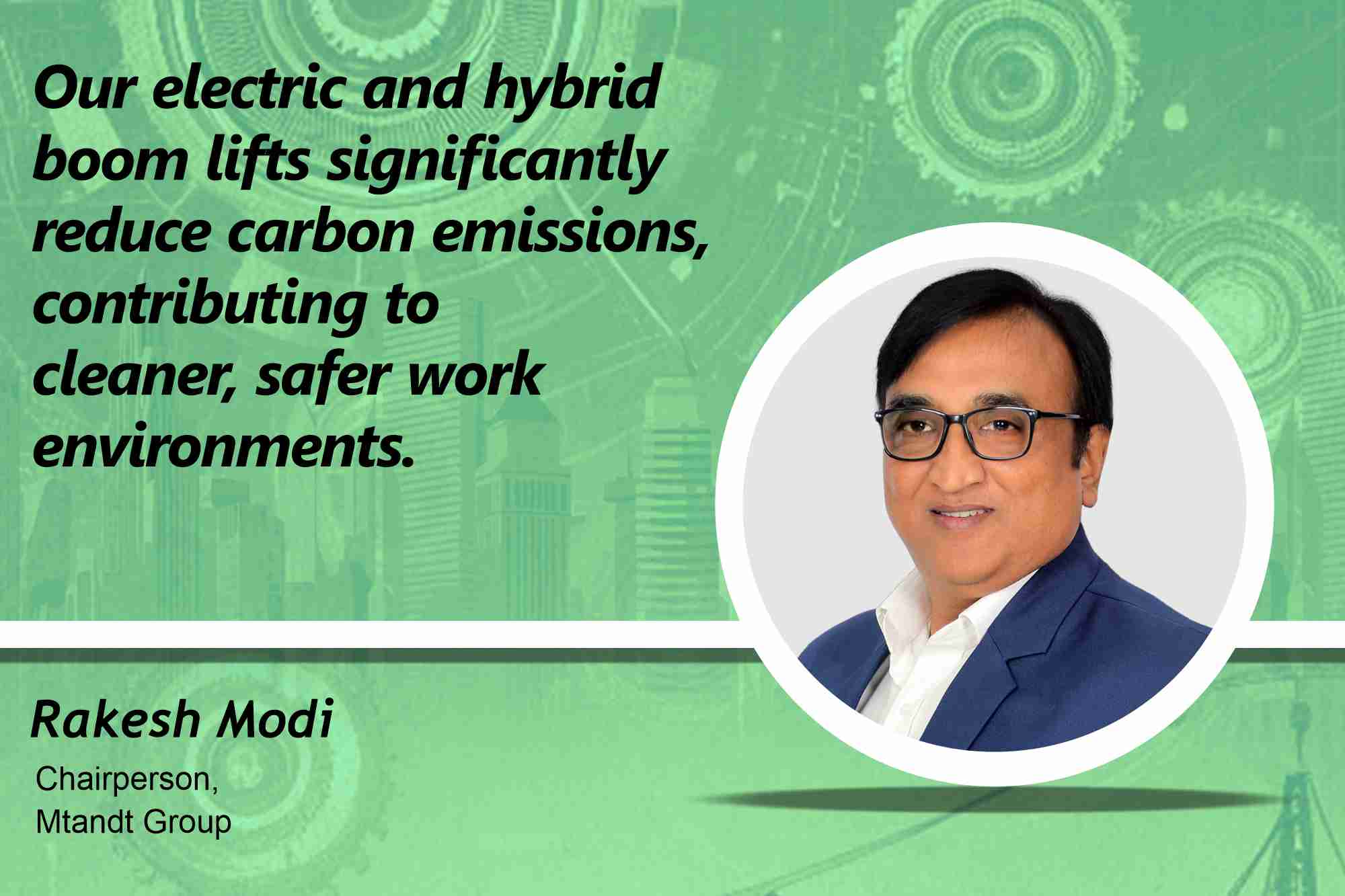Why rock breakers are most preferred for demolition
By Edit Team | April 17, 2019 12:24 pm SHARE

Considering environmental concerns, bent towards rock breaker is increasing for demolition purposes amid shrinking preference for blasting usage.
Rock breakers are ideal on a jobsite where demolition is the end goal. They are designed to demolish rock, concrete and intact construction materials, trenching and breaking asphalt, concrete, huge stones etc. Hydraulic rock breakers are mounted on excavators, wheel loaders, skid steers and tractor backhoes and work across a wide range of applications including trenching, construction, demolition, quarry, mining etc.
Most preferred for demolition
Rock breaker is the fastest and most preferred method of demolition for places where blasting is restricted. “In mining, secondary blasting can be avoided by using rock breakers which enhances productivity. By allowing continuous operations without interruption for the secondary blasting and clearing, a lot of time is saved,” says Pankaj Kumar, Vice President, DOZCO (India) Pvt Ltd.
Further, rock breakers for primary rock mining can reduce load on crushers, increasing primary crusher output and creating room for flexible planning. This method is environment-friendly as it eliminates blasting emissions and also improves safety by avoiding flying rocks.
“Rock breaker adds more productivity as one can have control over grain size distribution and reduce the fines which are generated by blasting the rocks,” says Rajnikant, Marketing Head, Fine Equipments India Pvt Ltd.
When blasted rocks are too big to be handled by loading equipment or the crusher, secondary reduction is required. Even with the most advance blasting techniques, there is a need to resize the boulders.
“Owing to features like auto stop and anti-blank fire system that improve efficiency, safety as well as performance, rock breaker is overshadowing the usage of blasting which is ultimately helping and boosting the market,” says Rajnikant. It can also be utilised in idle time with bucket and other attachment with the help of quick coupler.
Breaking huge materials
When it comes to large, unwieldy rocks, mines and quarries deploy rock breakers that can be visualised as big guns that serve as a kind of first assault in the ground war between rock and machine. After ore is blasted loose from the host rock, it comes in variety of shapes and sizes, never uniform. Surface operations typically employ jaw crushers or gyratory crushers, where material is brought to the crusher by large haul trucks and dumped into a rock box.
Underground operations don’t have the space for large crushers, so they typically use a steel grate called a grizzly to size material before it enters an ore pass. Material that is too large cannot pass through the openings in the grizzly and are left to be broken by a rock breaker, while the smaller material is allowed to pass through the grizzly down the ore pass. The ore chunks that are too large to go through the grizzly are piled next to, or on top of the grizzly, where excavators equipped with a hydraulic hammer break them down. Other mines choose to employ a stationary boom that can move the rocks around and break them so they can fall through the grizzly grates, according to M.V. Singh, Director- Sales & Marketing, Business Development, Juno Equipments India Pvt Ltd.
“The boom chosen to carry the selected breaker depends on its ability to provide full coverage of the area where material will require breaking, racking or clearing. The choice also depends on ore size, the production rate the mine wants to achieve, and rock hardness. The most powerful breakers will be used to break the hardest rock, such as iron ore or granite, while less-powerful breakers will be needed to bust medium-hardness rock like limestone or dolomite, or soft minerals like talc, slate or asbestos,” adds Singh.
Ground-breaking technologies
“The design of the DOZCO series of hydraulic breakers produces high-speed percussion, exceptional value along with durability and reliability for all demolition, rock-breaking requirements and construction,” says Kumar.
The DOZCO breaker range has been designed and built to work in specialist dedicated breaking applications. They are supplied ‘ready to go’ with hoses, moil, chisel tools. The design provides maximum strength with lower weight and the low maintenance accumulator helps reduce maintenance costs. The breakers feature a frame with a cylindrical design, providing improved access jobs in confined areas such as inside structures or holes. The breakers are equipped as standard with a special shield to protect hoses and fittings from being damaged when working close to the ground. The design of the breaker’s hydraulic system provides increased efficiency, ensuring a longer working time without risk of overheating.
• Frame: Fabricated out of high tensile strength plates. A matching high strength welding electrodes are used for homogenous welding of the breaker body.
• Hydraulic body and parts: Various alloy steel with accurate heat treatment process to cater the functional requirement.
• Bottom plate: High tensile wear resistance plate.
• Tool: Alloy steel with high wear resistance and high compressive stress absorbing properties.
• Piston: Optimised piston design ensures that the blow energy is efficiently transferred for excellent breaking energy.
“Fine breakers are designed with excellent power to weight ratio, shock absorbing system, auto-stop system (anti-blank fire system), auto-mated lubrication, through bolt-longest service life, underwater working, unique gas-charged piston maximises breaker efficiency, dust protection and impact energy to suit various rock conditions that creates trouble-free operation and deliver highest productivity compared to any other breaker,” says Rajnikant.
The material composition is of superior quality in terms of special steel and the heat treatment for making them perform under rugged conditions. Further, the breakers have lesser fed parts that make them lesser prone to maintenance.
“Our design is sleek and modern, adopted piston idle blow prevention function as standard, which reduced the vibration, Fine also reduced the no. of parts to simplify the maintenance, which lower the operating cost and improve impact force, powerful and durable,” Rajnikant adds.
Juno rock breaker TB 280-4 for 18-26 tonnes excavators is ideal for primary as well as secondary rock breaking. It is extensively used in mining belts where blasting is not allowed. It has optional features of automatic lubrication system to increase service life and air check valve for under water hammering.
In mining, secondary blasting can be avoided by using rock breakers which enhances the productivity.
Pankaj Kumar, Vice President, DOZCO (India) Pvt Ltd
Features like auto stop and anti-blank fire system improve efficiency, safety as well as performance.
Rajnikant, Marketing Head, Fine Equipments India Pvt Ltd
Material that is too large cannot pass through the openings in the grizzly and is left to be broken by a rock breaker.
M.V. Singh, Director- Sales & Marketing, Business Development, Juno Equipments India Pvt Ltd
Cookie Consent
We use cookies to personalize your experience. By continuing to visit this website you agree to our Terms & Conditions, Privacy Policy and Cookie Policy.



















